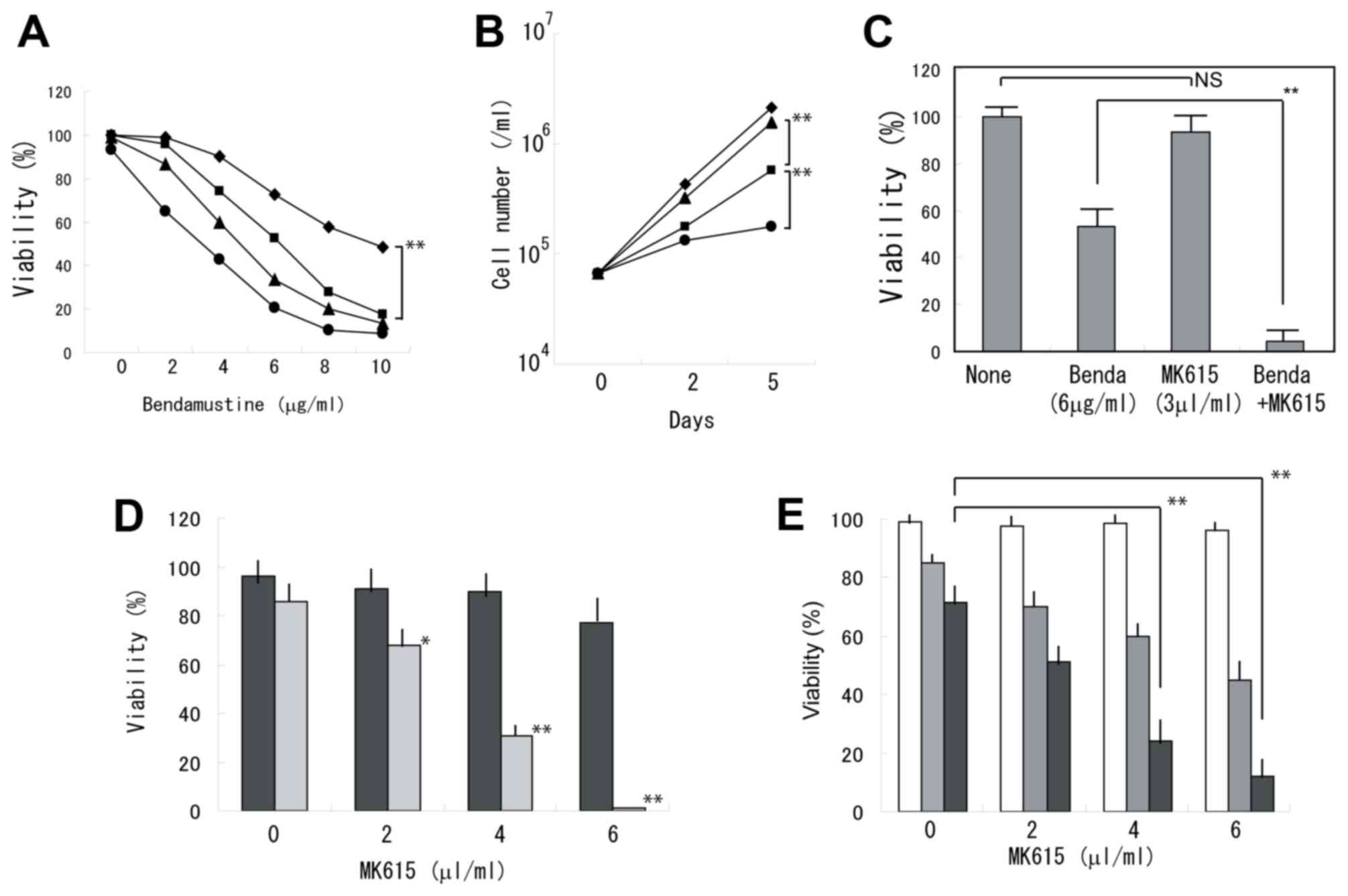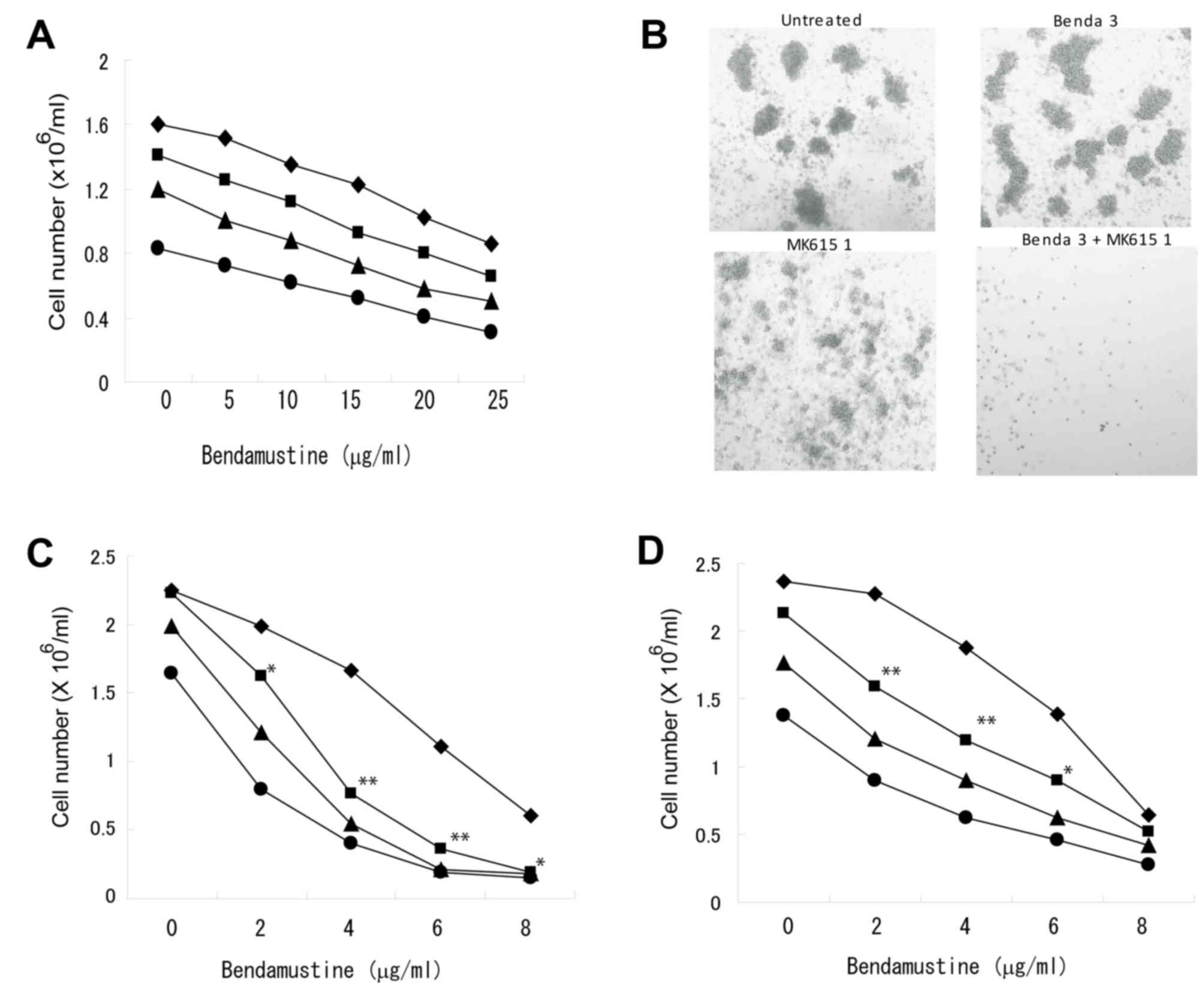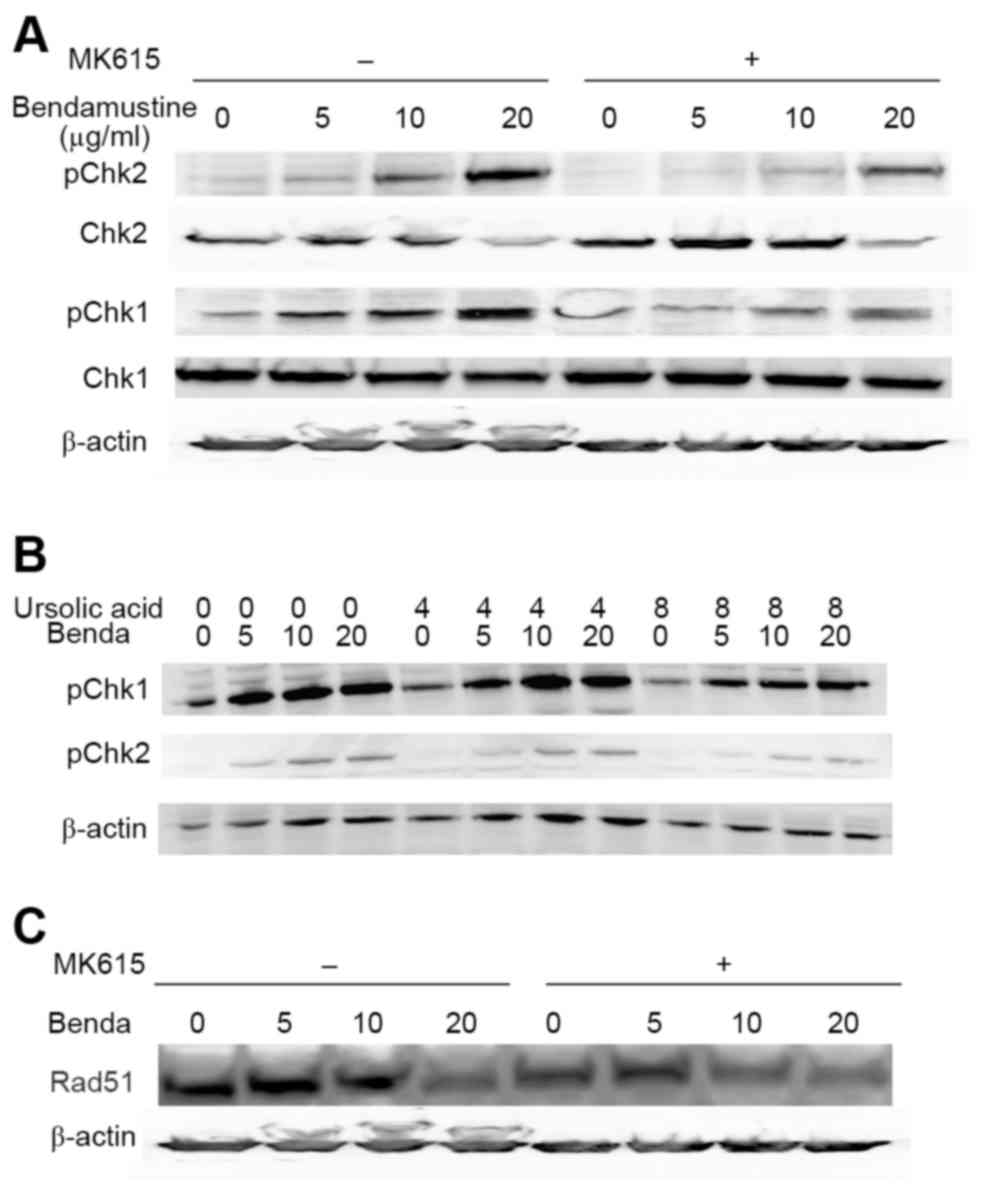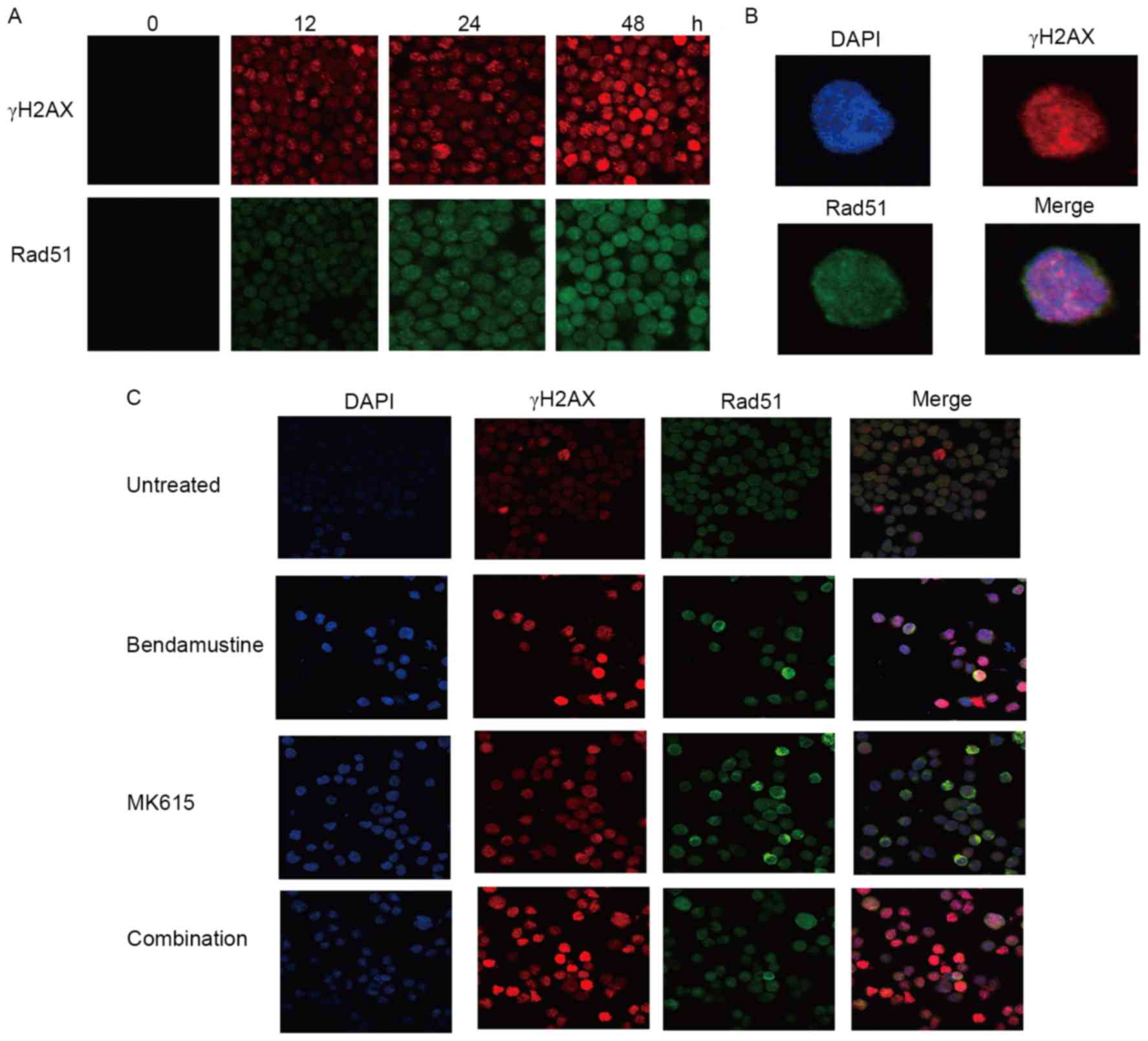Japanese apricot extract (MK615) potentiates bendamustine-induced apoptosis via impairment of the DNA damage response in lymphoma cells
- Authors:
- Published online on: May 19, 2017 https://doi.org/10.3892/ol.2017.6219
- Pages: 792-800
-
Copyright: © Inoue et al. This is an open access article distributed under the terms of Creative Commons Attribution License.
Abstract
Introduction
Bendamustine is a bifunctional alkylating agent that combines the alkylating properties of 2-chloroethylamine and the antimetabolite properties of a benzimidazole ring (1). Bendamustine acts primarily as an alkylating agent that induces interstrand DNA cross-linking and subsequent strand breaks (2), but partial cross-resistance suggests that bendamustine has an alternative underlying mechanism of action from that of other alkylating agents (3,4). Results of previous clinical trials have demonstrated that bendamustine is safe and effective as a single agent for the treatment of chronic lymphocytic leukemia (CLL) (5) and rituximab-resistant low-grade lymphomas (6). The clinical application of bendamustine has been extended to diffuse large B cell lymphoma (7) and aggressive lymphomas (8). Although bendamustine as a monotherapy and in combination with rituximab appears to be useful in treating CLL and untreated indolent lymphomas (5,9), combined chemotherapy with other therapeutic agents is required for the treatment of relapsed cases and refractory malignancies including aggressive lymphomas.
Combined chemotherapy remains the primary approach for patients with hematological malignancies. Previous preclinical studies have demonstrated the combined effects of bendamustine with other anticancer agents (10). Certain combinations have been applied clinically (11), but a precise investigation of their effects is required for validation. To establish safer and more effective regimens, in the present study, a systematic screening for suitable drugs to be used in combination with bendamustine for use against intractable lymphoid malignancies was conducted and the underlying molecular mechanisms for the effects of favorable combinations were investigated. In total, >50 compounds and extracts were examined, including anticancer agents, differentiation inducers and inhibitors of oncogenic signal transduction. Potentiation of the growth-inhibitory activities of various agents in human lymphoma BALM3 cells in the presence of bendamustine was evaluated by isobogram analysis, as described previously (12). As a result, it was identified that combinations of bendamustine and MK615, an extract of Japanese apricot, were favorable. Japanese apricot has been used for centuries as a traditional medicine and food in Japanese culture. Japanese apricot contains a number of chemicals, including citric acid, malic acid, cyanogenic glycosides and triterpenoids. MK615 is a sticky extract from Japanese apricot, called Ume in Japanese, and has been used for a number of years as an anti-inflammatory agent, for the treatment of intestinal disorders and as an antipyretic (13). A number of triterpenoids in MK615 are considered to exhibit antineoplastic effects. We and other investigators have reported previously that MK615 inhibits the proliferation of various cancer cells, including gastric, breast, hepatocellular, colon and pancreatic cancer cells (12,14,15). MK615 markedly suppressed cutaneous metastases in a patient with advanced malignant melanoma (16). These results suggest that MK615 may be useful for treating human malignant tumors. In the present study, the underlying molecular mechanisms for the synergism of MK615 and bendamustine were examined. The results of the present study may provide important information for the establishment of effective bendamustine-based regimens.
Materials and methods
Materials
MK615 (Misatol®GL) was prepared as described previously (12) and obtained from AdaBio Co., Ltd. (Takasaki, Japan). As Misatol®GL is a sticky extract, an equal volume of PBS was added to Misatol®GL. The 50% diluted Misatol®GL was used as MK615 solution. Ursolic acid and MTT were purchased from Sigma-Aldrich; Merck KGaA (Darmstadt, Germany). Bendamustine, VE-821 and KU-60019 were obtained from Selleck Chemicals (Houston, TX, USA). The general caspase inhibitor benzyloxycarbonyl-Val-Ala-Asp-fluoromethylketone (Z-VAD-FMK) was purchased from R&D Systems, Inc. (Minneapolis, MN, USA). Propidium iodide (PI) was purchased from BioVision Inc. (Milpitas, CA, USA).
Cells and cell culture
Human B cell lymphoma (BALM3, SU-DHL-4, U698 M and SKW4), lymphoblastoid (BALM1) and myeloma (RPMI8226) cells were cultured in suspension in RPMI-1640 medium (Sigma-Aldrich; Merck KGaA, Darmstadt, Germany) supplemented with 10% fetal bovine serum (BioWest, Nuaille, France) and 80 µg/ml gentamicin at 37°C in a humidified atmosphere containing 5% CO2. The characteristics of the lymphoid cell lines used in the present study have been described previously (17).
Assay of cell proliferation and viability
Cells were seeded at 1×105 cells/ml in a 24-well plate. Following culture with or without the test compounds for 2, 3, 4, 5, or 6 days, cell numbers were counted using a model Z1 Coulter Counter (Beckman Coulter, Inc., Brea, CA, USA). Cell viability was determined using either a modified MTT assay (12) or a trypan blue dye exclusion test using an automated cell counter (Bio-Rad Laboratories, Inc., Hercules, CA, USA).
Colony-forming assay
Cells (1×104 cells/dish) were plated into 1.1 ml semisolid methylcellulose medium containing 0.8% methylcellulose and 20% fetal bovine serum in triplicate for 14 days. A 0.1 ml volume of PBS containing various concentrations of MK615 and/or bendamustine was added to the semisolid medium. Images of colonies were captured using an inverted microscope.
Apoptosis assay
For examination of morphology, Cytospin slide preparations of >300 cells were stained with May-Grünwald-Giemsa. DNA fragmentation was analyzed as follows: Cells were collected following exposure to bendamustine and/or MK615, and DNA was extracted using an Apoptotic DNA Ladder Detection kit (Abcam Japan, Tokyo), according to the manufacturer's protocol. Equal amounts of DNA (1 µg) were analyzed by electrophoresis on 1.5% agarose gels stained with ethidium bromide.
For the Annexin V-binding assay, cells were labeled with fluorescein isothiocyanate-labeled Annexin V using an Annexin V-FITC kit (BioVision, Inc.). Following staining, cells were washed and analyzed by flow cytometry using a BD FACSCalibur™ instrument and BD CellQuest Pro (version 6.0) software (both BD Biosciences, San Jose, CA, USA).
Western blot analysis
Cells were packed following washing with ice-cold PBS and then lysed at a concentration of 1×107 cells/ml in lysis buffer (Sample Buffer; Wako Pure Chemical Industries, Ltd., Osaka, Japan). Protein concentration was quantified using Protein Quantification Kit-Rapid (Wako Pure Chemical Industries, Ltd.). Equal amounts of protein (10 µg) were separated by SDS/PAGE (10% gels) prior to transfer to a polyvinylidene fluoride membrane (Bio-Rad Laboratories), and then blocked with Block Ace (DS Pharma Biomedical Co., Ltd, (Osaka, Japan) for 60 min at room temperature. The membranes were incubated with anti-phospho (p) checkpoint kinase (Chk) 1, Chk1, pChk2, Chk2 and β-actin antibodies (nos. 2349, 2360, 2197, 6334, and 4970; Cell Signaling Technology, Inc.; dilution, 1:500) at 4°C overnight. Active caspase-3 was examined by western blot analysis using anti-cleaved caspase-3 antibody (no. 9664; Cell Signaling Technology, Inc., Danvers, MA, USA; dilution, 1:500). All western blots presented are representative of ≥3 independent experiments.
Immunofluorescence
All procedures were performed at room temperature. Cells were fixed with 4% paraformaldehyde in PBS for 10 min, and then permeabilized with 0.3% Tween-20 for 15 min. Following fixation, cells were washed three times with PBS and then blocked with blocking buffer (1% bovine serum albumin in PBS) for 60 min. Cells were incubated with an anti-Rad51 (ab213; Abcam, Cambridge, UK) and anti-phosphorylated histone H2AX (γH2AX) (no. 9718; Cell Signaling Technology, Inc.) antibodies (both dilution, 1:100) for 60 min, washed with blocking buffer and incubated for 60 min with Alexa Fluor® 488-conjugated anti-mouse and Alexa Fluor® 594-conjugated anti-rabbit secondary antibodies (nos. 4408 and 8889; Cell Signaling Technology, Inc.; dilution, 1:100). Confocal images were captured using an inverted microscope (Olympus, Tokyo, Japan). All immunofluorescence experiments were repeated three times.
Statistical analysis
Results are expressed as the mean ± standard deviation. Pairs of data were compared using Student's t-test. P<0.05 was considered to indicate a statistically significant difference.
Results
Combined effects of bendamustine and MK615 on the proliferation of lymphoma and myeloma cells
Bendamustine exhibited synergistic effects with MK615 in inhibiting the viability of BALM3 cells (Fig. 1A). When the cells were treated with 6 µg/ml bendamustine alone, the cells continued to proliferate, although the viability was markedly decreased. Whereas MK615 at 3 µl/ml exhibited a limited effect on cell viability, proliferation was almost completely prevented by the combined treatment of MK615 and bendamustine (Fig. 1B). At 5 days, viability was significantly decreased following treatment with bendamustine plus MK615 (Fig. 1C). Similar results were obtained in the other lymphoma cell lines (Fig. 1D and E). RPMI8226 myeloma cells were less sensitive to bendamustine and the combination with MK615 was less effective (Fig. 2A). A colony-forming assay indicated that the combination of bendamustine and MK615 completely suppressed colony formation by BALM3 cells, although bendamustine at 3 mg/ml had only a limited effect on colony formation (Fig. 2B). As MK615 contains a number of triterpenoids that exhibit antitumor activities (15), the effect of chemically defined triterpene on the proliferation of lymphoma cells was examined. The combination of bendamustine and ursolic acid, one of the major components of MK615, inhibited the proliferation of BALM3 cells (Fig. 2D), but was slightly less effective than the combined effects of bendamustine and MK615 (Fig. 2E).
Induction of apoptosis in BALM3 cells treated with bendamustine and MK615
When BALM3 cells were exposed to 25 µg/ml bendamustine and 7.5 µl/ml MK615 for 24 h, morphological analysis revealed shriveled cells, chromatin condensation, nuclear fragmentation and cytoplasmic blebbing, whereas these morphological changes were rarely observed in cells treated with 25 µg/ml bendamustine alone (Fig. 3A). The induction of apoptosis was confirmed by gel electrophoresis of DNA from cells exposed to bendamustine and MK615 (Fig. 3B), induction of cleaved caspase-3 (Fig. 3C) and the expression of Annexin V (Fig. 3D). Annexin V-positive cells were induced by 6 µg/ml bendamustine, but MK615 had limited effect on Annexin V expression. MK615 markedly increased the bendamustine-induced Annexin V expression. After 48 h, PI+ Annexin V+ cells were 0.88, 1.11, 18.9 and 34.15% in untreated, MK615-treated, bendamustine-treated and MK615 plus bendamustine-treated cells, respectively (Fig. 3D). The induction of Annexin V expression by bendamustine plus MK615 was significantly inhibited by the general caspase inhibitor Z-VAD-FMK (Fig. 3E). These results indicate that combined treatment with bendamustine and MK615 effectively induced caspase-dependent apoptosis in BALM3 cells.
Effect of MK615 on the bendamustine-induced DNA damage response
Alkylating agents including bendamustine activate a DNA damage response (10). ATM and ATR are central to the entire DNA damage response and directly regulate at least two effector kinases: Chk1 and Chk2 (18). We examined phosphorylation of the kinases in BALM3 cells treated with bendamustine for 6, 12, and 24 h. Bendamustine induced marked phosphorylation of Chk1 and Chk2 at 24 h, whereas MK615 did not (Fig. 4A). MK615 substantially inhibited the phosphorylation of Chk1 and Chk2 between 12 and 24 h, although this inhibition by MK615 was not observed at 6 h, suggesting that bendamustine rapidly induced phosphorylation of the checkpoint kinases, and phosphorylation was gradually suppressed by MK615. Ursolic acid, one of the major components of MK615, also markedly inhibited phosphorylation of the kinases, as did MK615 (Fig. 4B).
Effects of ATR/ATM inhibitors on bendamustine-induced proliferation inhibition of BALM3 cells
As Chk1 and Chk2 are phosphorylated by ATM and ATR (18), the aforementioned results suggest that MK615 effectively inhibited the activities of ATM and/or ATR. Therefore, the effects of ATR and ATM inhibitors on bendamustine-induced proliferation inhibition were examined (Fig. 5). VE-821 (an ATR inhibitor) and KU-60019 (an ATM inhibitor) significantly enhanced the bendamustine-induced proliferation inhibition of BALM3 cells (P<0.01), whereas these inhibitors exhibited a limited effect on MK615-induced proliferation inhibition (Fig. 5A), suggesting that these inhibitors have the same mechanism of action as that of MK615. The combination of VE-821 and KU-60019 significantly increased the inhibition of bendamustine-induced proliferation compared with VE-821 or KU-60019 alone (Fig. 5B). Similar results were obtained in other lymphoid cells, although the effects differed among the cell lines (Fig. 5C).
Suppression of bendamustine-induced formation of Rad51 foci by MK615
BALM3 cells treated with bendamustine exhibited an early increase in the number of γH2AX, a marker of DNA damage, and of Rad51 nuclear foci, which are the sites of repair of DNA damage (Fig. 6A and B). MK615 did not exhibit any marked effect on the number of γH2AX and Rad51 foci in the absence of bendamustine, but markedly increased the number of bendamustine-induced γH2AX foci. However, the number of bendamustine-induced Rad51 foci was not increased by MK615 (Fig. 6C). As presented in Fig. 4C, bendamustine decreased the amount of Rad51 protein in BALM3 cells in the presence or absence of MK615. These results suggest that MK615 suppresses Rad51 assembly and stimulates its degradation, independent of DNA damage.
Discussion
Previous studies have investigated the combined effects of bendamustine and various agents on the activation of cell-death pathways in malignant cells. These agents have included navitoclax (an inhibitor of B cell lymphoma 2), everolimus (an inhibitor of mammalian target of rapamycin), SGI-1776 (an inhibitor of Pim kinase), entinostat (an inhibitor of histone deacetylase) and YM155 (an inhibitor of survivin) (19–23). Entinostat was identified to enhance the bendamustine-induced phosphorylation of Chk2 (22), whereas YM155 inhibited the bendamustine-induced activation of the ATM signaling pathway (23). The results of the present study indicate that MK615 inhibited the bendamustine-induced activation of the ATM and ATR signaling pathways. The formation of nuclear foci of Rad51 induced by bendamustine was effectively inhibited by MK615, suggesting that MK615 suppresses the DNA damage repair induced by bendamustine. A previous study indicated that MK615 markedly suppressed cutaneous in-transit metastasis in a patient with advanced malignant melanoma (16). M615 significantly inhibited the proliferation of human pancreatic cancer cells as xenografts without apparent adverse effects and exhibited synergistic effects with gemcitabine (12). In advanced cases and recurrence, the use of supplements is expected to augment the antineoplastic effects of cancer drugs. Various standardized extracts or fractions with anticancer effects or with adjuvant therapy in cancer treatment obtained from single or mixed herbs are accepted as dietary supplements and botanical drug products in the USA on the basis of current statutory regulations (24). Certain supplements may enhance the inhibitory effects of anticancer agents on many cancers. Japanese apricot has been used for centuries as a traditional medicine and food in Japanese culture. MK615 is a supplement produced from Japanese apricot that may be a useful for treating human malignancies, and further studies are warranted to evaluate its clinical effectiveness and to elucidate its precise mechanism of action.
It is hypothesized that targeting ATR and ATM may selectively sensitize cancer cells, but not normal cells, to DNA damage, therefore selective inhibitors of ATM and ATR are currently in preclinical and clinical development (18,25). As these inhibitors and bendamustine synergistically inhibited the proliferation of lymphoma cells, combination therapy with bendamustine and ATM/ATR inhibitors may be useful in the treatment of malignant lymphoma. Further preclinical and clinical studies may lead to new possibilities in the therapy of lymphoid malignancies.
B lymphoma cells are sensitive to bendamustine, and the combined treatment with MK615 was more marked in B lymphoma cells. RPMI18226 myeloma cells were less sensitive to bendamustine and the combination with MK615 was less effective. Similar results were obtained in other myeloma cell lines and certain myeloid leukemia cell lines. These results suggest that the combined therapy may be useful in the treatment of B lymphoma.
Acknowledgements
The present study was supported by the SUIGAN project, Shimane University, and Japan Blood Products Organization, Japan. J.S. received research funding from Chugai Pharmaceutical Co., Ltd.; Kyowa Hakko Kirin Co., Ltd.; Eisai Co., Ltd.; Takeda Pharmaceutical Co., Ltd.; Astellas Pharma Inc.; and Toyama Chemical Co., Ltd.
References
|
Tageja N and Nagi J: Bendamustine: Something old, something new. Cancer Chemother Pharmacol. 66:413–423. 2010. View Article : Google Scholar : PubMed/NCBI | |
|
Hartmann M and Zimmer C: Investigation of cross-link formation in DNA by the alkylating cytostatic IMET 3106, 3393 and 3943. Biochim Biophys Acta. 287:386–389. 1972. View Article : Google Scholar : PubMed/NCBI | |
|
Strumberg D, Harstrick A, Doll K, Hoffmann B and Seeber S: Bendamustine hydrochloride activity against doxorubicin-resistant human breast carcinoma cell lines. Anticancer Drugs. 7:415–421. 1996. View Article : Google Scholar : PubMed/NCBI | |
|
Leoni LM, Bailey B, Reifert J, Bendall HH, Zeller RW, Corbeil J, Elliott G and Niemeyer CC: Bendamustine (Treanda) displays a distinct pattern of cytotoxicity and unique mechanistic features compared with other alkylating agents. Clin Cancer Res. 14:309–317. 2008. View Article : Google Scholar : PubMed/NCBI | |
|
Knauf WU, Lissichkov T, Aldaoud A, Liberati A, Loscertales J, Herbrecht R, Juliusson G, Postner G, Gercheva L, Goranov S, et al: Phase III randomized study of bendamustine compared with chlorambucil in previously untreated patients with chronic lymphocytic leukemia. J Clin Oncol. 27:4378–4384. 2009. View Article : Google Scholar : PubMed/NCBI | |
|
Friedberg JW, Cohen P, Chen L, Robinson KS, Forero-Torres A, La Casce AS, Fayad LE, Bessudo A, Camacho ES, Williams ME, et al: Bendamustine in patients with rituximab-refractory indolent and transformed non-Hodgkin's lymphoma: Results from a phase II multicenter, single-agent study. J Clin Oncol. 26:204–210. 2008. View Article : Google Scholar : PubMed/NCBI | |
|
Ohmachi K, Niitsu N, Uchida T, Kim SJ, Ando K, Takahashi N, Takahashi N, Uike N, Eom HS, Chae YS, et al: Multicenter phase II study of bendamustine plus rituximab in patients relapsed or refractory diffuse large B-cell lymphoma. J Clin Oncol. 31:2103–2109. 2013. View Article : Google Scholar : PubMed/NCBI | |
|
McCloskey JK, Broome CM and Cheson BD: Safe and effective treatment of aggressive non-Hodgkin lymphoma with rituximab and bendamustine in patients with severe liver impairment. Clin Adv Hematol Oncol. 11:184–188. 2013.PubMed/NCBI | |
|
Rummel MJ, Niederle N, Maschmeyer G, Banat GA, von Grünhagen U, Losem C, Kofahl-Krause D, Heil G, Welslau M, Balser C, et al: Bendamustine plus rituximab versus CHOP plus rituximab as first-line treatment for patients with indolent and mantle-cell lymphomas: An open-label, multicentre, randomized, phase 3 non-inferiority trial. Lancet. 381:1203–1210. 2013. View Article : Google Scholar : PubMed/NCBI | |
|
Hiraoka N, Kikuchi J, Yamauchi T, Koyama D, Wada T, Uesawa M, Akutsu M, Mori S, Nakamura Y, Ueda T, et al: Purine analog-like properties of bendamustine underlie rapid activation of DNA damage response and synergistic effects with pyrimidine analogues in lymphoid malignancies. PLoS One. 9:e906752014. View Article : Google Scholar : PubMed/NCBI | |
|
Visco C, Finotto S, Zambello R, Paolini R, Menin A, Zanotti R, Zaja F, Semenzato G, Pizzolo G, D'Amore ES and Rodeghiero F: Combination of rituximab, bendamustine, and cytarabine for patients with mantle-cell non-Hodgkin lymphoma ineligible for intensive regimens or autologous transplantation. J Clin Oncol. 31:1442–1449. 2013. View Article : Google Scholar : PubMed/NCBI | |
|
Hattori M, Kawakami K, Akimoto M, Takenaga M, Suzumiya J and Honma Y: Antitumor effect of Japanese apricot extract (MK615) on human cancer cells in vitro and in vivo through a reactive oxygen species-dependent mechanism. Tumori. 99:239–248. 2013.PubMed/NCBI | |
|
Adachi M, Suzuki Y, Mizuta T, Osawa T, Adachi T, Osaka K, Suzuki K, Shiojima K, Arai Y, Masuda K, et al: The ‘Prunus mume Sieb. et Zucc’ (Ume) is a rich natural source of novel anti-cancer substance. Int J Food Prop. 10:375–384. 2007. View Article : Google Scholar | |
|
Gutterman JU, La HT, Yang P, Haridas V, Gaikwad A and Marcus S: Effects of the tumor inhibitory triterpenoid avicin G on cell integrity, cytokinesis, and protein ubiquitination in fission yeast. Proc Natl Acad Sci USA. 102:pp. 12771–12776. 2005; View Article : Google Scholar : PubMed/NCBI | |
|
Yamai H, Sawada N, Yoshida T, Seike J, Takizawa H, Kenzaki K, Miyoshi T, Kondo K, Bando Y, Ohnishi Y and Tangoku A: Triterpenes augment the inhibitory effects of anticancer drugs on growth of human esophageal carcinoma cells in vitro and suppress experimental metastasis in vivo. Int J Cancer. 125:952–960. 2009. View Article : Google Scholar : PubMed/NCBI | |
|
Matsushita S, Tada K, Kawahara K, Kawai K, Hashiguchi T, Maruyama I and Kanekura T: Advanced malignant melanoma responds to Prunus mume Sieb. Et Zucc (Ume) extract: Case report and in vitro study. Exp Ther Med. 1:569–574. 2010.PubMed/NCBI | |
|
Niitsu N, Higashihara M and Honma Y: Human B-cell lymphoma cell lines are highly sensitive to apoptosis induced by all-trans retinoic acid and interferon-gamma. Leuk Res. 26:745–755. 2002. View Article : Google Scholar : PubMed/NCBI | |
|
Weber AM and Ryan AJ: ATM and ATR as therapeutic targets in cancer. Pharmacol Ther. 149:124–138. 2015. View Article : Google Scholar : PubMed/NCBI | |
|
Ackler S, Mitten MJ, Chen J, Foster K, Jin S, Phillips DC, Schlessinger S, Wang B, Leverson JD and Boghaert ER: Navitoclax (ABT-263) and bendamustine ± rituximab induce enhanced killing of non-Hodgkin's lymphoma tumours in vivo. Br J Pharmacol. 167:881–891. 2012. View Article : Google Scholar : PubMed/NCBI | |
|
Lu B, Li J, Pan J, Huang B, Liu J and Zheng D: Everolimus enhances the cytotoxicity of bendamustine in multiple myeloma cells through a network of pro-apoptotic and cell-cycle-progression regulatory proteins. Acta Biochim Biophys Sin (Shanghai). 45:683–691. 2013. View Article : Google Scholar : PubMed/NCBI | |
|
Yang Q, Chen LS, Neelapu SS and Gandhi V: Combination of Pim kinase inhibitor SGI-1776 and bendamustine in B-cell lymphoma. Clin Lymphoma Myeloma Leuk. 13 Suppl 2:S355–S362. 2013. View Article : Google Scholar : PubMed/NCBI | |
|
Cai B, Lyu H, Huang J, Wang S, Lee CK, Gao C and Liu B: Combination of bendamustine and etinostat synergistically inhibits proliferation of multiple myeloma cells via induction of apoptosis and DNA damage response. Cancer Lett. 335:343–350. 2013. View Article : Google Scholar : PubMed/NCBI | |
|
Kaneko N, Mitsuoka K, Amino N, Yamanaka K, Kita A, Mori M, Miyoshi S and Kuromitsu S: Combination of YM155, a surviving suppressant, with bendamustine and rituximab: A new combination therapy to treat relapse/refractory diffuse large B-cell lymphoma. Clin Cancer Res. 20:1814–1822. 2014. View Article : Google Scholar : PubMed/NCBI | |
|
Feng Y, Wang N, Zhu M, Feng Y, Li H and Tsao S: Recent progress on anticancer candidates in patents of herbal medicinal products. Recent Pat Food Nutr Agric. 3:30–48. 2011. View Article : Google Scholar : PubMed/NCBI | |
|
Fokas E, Prevo R, Hammond EM, Brunner TB, McKenna WG and Muschel RJ: Targeting ATR in DNA damage response and cancer therapeutics. Cancer Treat Rev. 40:109–117. 2014. View Article : Google Scholar : PubMed/NCBI |















